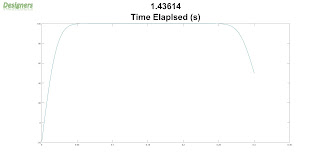This post is about the simulation of hypersonic flow over a heated circular cylinder, in two dimensions.
Equation 1 is used as a relationship between Mach and the Reynold number.
M= Re*μ*√(R*T) ÷ d*P*√γ (1)
w.r.t. equation 1, the parameters represent the following quantities.
M Freestream Mach number at 17.6
Re Reynolds number at 376,000
μ Dynamic viscosity at 1.329045e-5 Ns.m-2
R Specific gas constant at 286.9 J.(kg.K)-1
T Freestream temperature 200 K
d Cylinder diameter at 5.6730225e-4 m
P Freestream pressure at 101325 Pa
γ Specific heat ratio at 1.4
Tw Wall temperature of cylinder at 500 K
Pr Prandtl number at 0.736
M Freestream Mach number at 17.6
Re Reynolds number at 376,000
μ Dynamic viscosity at 1.329045e-5 Ns.m-2
R Specific gas constant at 286.9 J.(kg.K)-1
T Freestream temperature 200 K
d Cylinder diameter at 5.6730225e-4 m
P Freestream pressure at 101325 Pa
γ Specific heat ratio at 1.4
Tw Wall temperature of cylinder at 500 K
Pr Prandtl number at 0.736
The boundary conditions were taken from [1]. A comparison with [1] is shown in Fig. 1. Inside Fig. 1, the red dotted line with circles represents the data from [1]. The black solid line represents the data from the present simulation. Within Fig. 1, 0° represents the stagnation point. The velocity, pressure, Mach number and temperature contours are shown in Fig. 2.
Fig. 1 A comparison with previous research [1].
Fig. 2, Top Row, L-R: Velocity and pressure contours. Bottom Row, L-R: Mach number and temperature contours.
The computational mesh and the computational domain with boundary conditions visible are shown in Fig. 3-4, respectively. The computational domain had a size of 20D x 20D. The mesh had 836,580 total cells and 944 cells were located at the solid fluid boundary. Several local mesh controls were employed to capture the shockwave properly.
Fig. 3, The computational mesh.
Fig. 4, The computational domain.
The solution method is Finite Volume method. SIMPLE-R is the solver employed. Implicit central difference scheme for diffusion
terms, second-order Upwind scheme for convective terms and first-order implicit
for temporal terms are used. The mesh created uses the Cartesian mesh with Immersed Boundary method.
Reference:
Thank you for reading. If you would like to collaborate on research projects, please reach out. I am looking for a PhD position, any guidance would be appreciated.




























